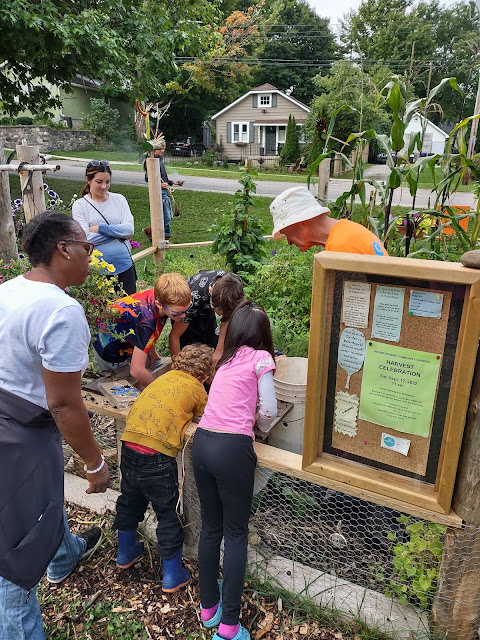The Wild Grapes have been whispering to us. “It is time.
It is time.” We’ve been watching
their transformation since the grape vines flowered in the spring. This year, there seemed to be a lot of grape
flowers on the side of the walking trail that we frequent. Soon, we noticed large clusters of small
green orbs appearing as if by magic. We
watched them grow larger and larger throughout the summer. When they began to blush pink, then pinkish
purplish blue, we paid close attention.
Soon, they were dark blue but still hard to the touch. Last week we noticed that they were soft and
flavourful when tasted. “It is time to pick us,” they whispered.
I spent last Saturday in an Indigenous Culture Competency
workshop with a local Indigenous teacher, Kelly Brownbill. She provided an excellent foundation for us
to later “build a house of knowledge on,” as she put it. Some of the information was new for me and
some of it strengthened what I had already learned from other authors and
teachers.
I have been thinking a lot lately about ancestral traumas
and how my ancestors brought the worldview of scarcity to Turtle Island. Instead of seeing the abundance as a cure for
this scarcity, they moved into greed which resulted in the death of 80% of the
people Indigenous to these territories, the extirpation of some species of
birds and animals and the deforestation of thousands of acres of land. Kelly explained the worldview of the
Europeans coming to Turtle Island in which the monarch was the supreme ruler and
the aristocracy took way more than their fair share of resources. Despite the warnings about greed in the
Christian teachings, greed was the sign of success. This is still true today in Western
non-Indigenous culture. And so, scarcity
hoping for abundance turned into greed and destruction in the face of actual
abundance. This seems to me, to be an
ancestral trauma in need of healing.
This morning, in the gentle fall rain, my partner and I renewed
our relationship with the Wild Grapes that grow beside the dock where we tie up
our canoes. We asked their permission to
pick and they were happy to say yes. We
gave them an offering in reciprocity and then we begin to break the clusters
off of the vines. There were a lot of them
and they hung in beautiful clusters. I
felt the ancestral desire to get as many as I could rise up in me. I didn’t name it greed but that is exactly
what it was. I was picking quickly, as
if there was someone approaching who would take them if I wasn’t fast
enough. But, we were alone. There was no actual threat. Wild Grapes are a
treat for us, not my main food source.
We give most of the jelly we make to our friends and neighbours. There is absolutely no need for greed. I became conscious of this ancestral trauma
rising up in need of healing.
I don’t exactly know
how to do this healing. It seems to be a relatively new idea for non-Indigenous
people who see themselves as the perpetrators of trauma, not realizing where it
comes from to think about healing the trauma they carry. And so, I am finding
my way, making this up as I go along, co-creating healing experiences with
nature. I took some deep breaths and
stopped picking. An idea came to me. What if I thank each cluster for their gift
as I break them off of the vine. So,
that’s what I did. My body changed. I slowed down. Efficiency became null and void. Presence, gratitude and appreciation were
what was important. We picked only what
we could reach from our feet and left lots of grapes up high for the birds who
do need these grapes for their food.
There were enough for all of us.
Dr. Gabor Mate talks about holding compassionate space for
healing and he does that beautifully for his patients. And so, I held a compassionate space for
myself as I became conscious of the impulse for taking as much as I could arose
in me. I didn’t beat myself up. I simply noticed it and felt the fear of
scarcity that was underneath it. What we
love softens and as I held a compassionate space for myself, the fear
diminished as did the greed that arose out of it. Instead of being driven by unconscious
trauma, I became conscious of it and could then choose to slow down, calm down
and feel gratitude. My body slowed down,
calmed down and softened. I could be
present in the actual moment instead of being driven by an ancestral past.
Perhaps healing ancestral trauma is a series of healing
events. Perhaps some of these are done
on a personal level and some are done at a collective level. I do believe that as we get better at this,
it is possible for a shift in “society” to take place. As an older woman, I have the freedom of time
and space to experiment with this, to reflect on my experience and to listen to
the whispers of the Wild Grapes. It’s
what I feel called to do. It’s where I
want to share my gifts just as the Grapes share theirs.
.JPG)

.JPG)

.jpg)

